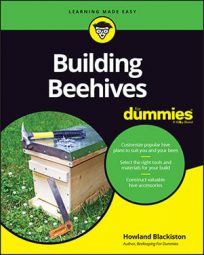The roof of your beehive takes the brunt of abuse from sun, rain, snow, and other climatic challenges. The roof (or outer cover) is a critical component for keeping your hive dry and your bees safe from the elements.
Roofing materials for beehives
You can optimize the roof’s effectiveness and maximize its durability by adding some form of weatherproofing (just like the roof on your house). Most of the following options are interchangeable with one another. Pick the roofing material that best meets your needs and preferences.
Aluminum flashing: Many beehive designs specify aluminum flashing as a good roof material. This is the stuff that’s used on the roofs of houses as a moisture barrier. It’s easy to cut (with tin snips or even a utility knife) and a breeze to bend and shape. It’s also readily available from any home improvement store. Aluminum flashing works well for both flat- and peaked-roof hives.
Asphalt roofing shingles: This option is a little fussier because the application of roofing shingles takes a bit more work than some of these other options. But shingles are very practical and can give your hive a “little house” appearance.
Roofing shingles come in a huge selection of colors. They work best on peaked-roof hives. Use a roofing nail that’s short enough that it won’t go all the way through both the shingles and the wooden hive top (3/4 inch should be ample).
Cedar shake shingles: Now we’re talking! This option results in a very elegant cottage look. If you’re selling your handiwork, this roof treatment would be very attractive to potential buyers. You won’t find this kind of stylishness in your typical beekeeping supply catalogue.
Roofing shingles work best on peaked-roof hives. Use a roofing nail that’s short enough that it won’t go all the way through both the shingles and the wooden hive top (3/4 inch should be ample).
Copper flashing: This is similar to aluminum flashing, but, as the name indicates, it’s made of copper. It’s pricey, but it can really dress up a hive if such aesthetics are important to you. Copper weathers to a soft green patina (like the Statue of Liberty).
If you’re building hives to sell, this extra bit of bling can be attractive to buyers and even command premium prices for your hives. Copper flashing tends to be available in a heavier gauge than aluminum flashing, so it’s a little more difficult to cut (tin snips work best) and even trickier to bend. Copper flashing works well for both flat- and peaked-roof hives.
Roofing felt paper: Also called tar paper, this material is made of glass fiber infused with tar and asphalt. It makes a very practical but not very elegant roofing material for any beehive. It’s easy to cut with heavy duty scissors or a utility knife and can be tacked to the hive’s roof using a heavy-duty staple gun (be sure to use stainless steel staples to prevent rusting).
It can wear out or tear over time, so you may have to replace it every few years. Felt paper works well for both flat- and peaked-roof hives.
When purchasing any of these roofing materials, you’ll likely wind up with a lot of surplus material (unless you plan to make a number of hives). For example, aluminum flashing is typically sold in a 10-foot roll, and you only need around 2 feet of flashing for the roof of one hive.
So rather than purchase more than you need, visit a home construction site and see if the foreman is willing to give you some leftover material to cover the roof on your hive. You don’t need that much for one hive. A jar of honey may just be the perfect barter for a couple of feet of flashing or a few dozen roof shingles!
Screening materials for beehives
A few beehive designs might call for screening material designed to keep the bees contained in a given area. But this isn’t your ordinary window screening material (that stuff is too fine, and the bees would surely clog it up with propolis). Instead, the screening material of choice for beekeeping is hardware cloth.
This consists of wire that’s woven and welded into a grid. Specifically, you need hardware cloth with 1/8-inch square openings. It’s known as #8 hardware cloth. It typically comes in 3-foot-by-10-foot rolls. If your local hardware store doesn’t have #8 hardware cloth (they likely won’t), you can easily find it online.
Some beekeeping supply stores are now selling it by the foot (see bee commerce or Brushy Mountain Bee Farm). You can cut hardware cloth to size using tin snips or even a pair of extra-heavy-duty scissors.

